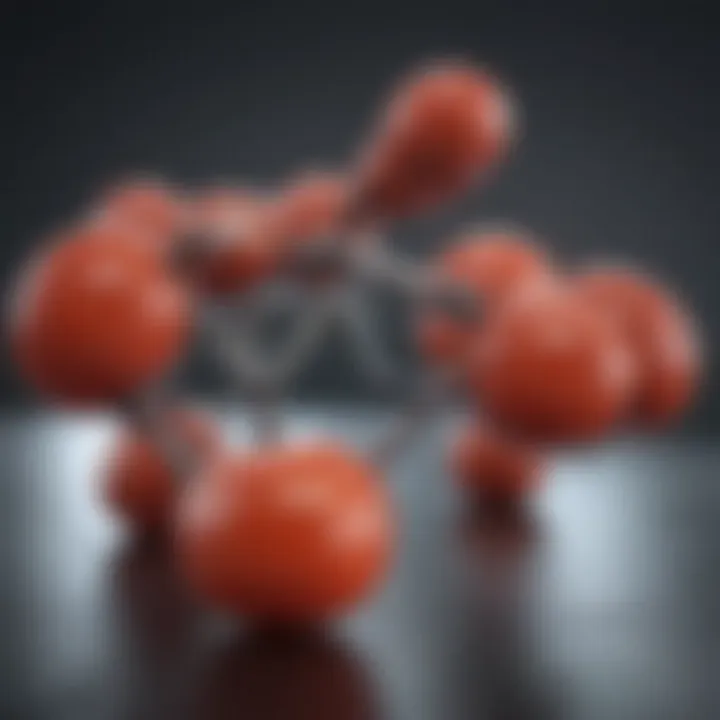Norfloxacin: Implications and Clinical Insights


Intro
Norfloxacin is a fluoroquinolone antibiotic that plays a significant role in modern medicine. First introduced in the late 1980s, it has been utilized for treating various bacterial infections, particularly urinary tract infections and bacterial gastroenteritis. Understanding Norfloxacin encompasses knowledge of its pharmacology, therapeutic applications, and safety profile. This overview aims to dissect the multiple dimensions surrounding Norfloxacin, focusing on its effectiveness and the challenges posed by increasing antibiotic resistance. Central to this article is the notion that responsible antibiotic use is crucial in combating the rise of resistant bacterial strains that threaten public health.
Research Overview
Methodological Approaches
The study of Norfloxacin involves various methodologies, including clinical trials, pharmacokinetic studies, and microbiological assessments. Clinical trials evaluate the drug's efficacy and safety compared to other antibiotics. Pharmacokinetic studies assess how Norfloxacin is absorbed, distributed, metabolized, and excreted in the body. Microbiological assessments further analyze the spectrum of bacteria affected by the drug, providing insight into its range of applications.
"Antibiotic resistance is a growing public health concern that necessitates a careful examination of our current therapies."
Significance and Implications
The significance of Norfloxacin extends beyond its clinical applications. As antibiotic resistance becomes more prevalent, understanding the implications of using Norfloxacin is paramount. This antibiotic serves as a case study for the broader issue of antibiotic stewardship. By evaluating its use in treating infections, researchers can glean insights into patterns of resistance and identify the best practices for prescribing such medications.
Current Trends in Science
Innovative Techniques and Tools
Advancements in medical research continue to shape the understanding and application of Norfloxacin. Techniques such as genomic sequencing and bioinformatics are being applied to analyze bacterial genomes to identify resistance mechanisms. These innovations contribute to a more detailed understanding of how bacteria develop resistance, which is critical for informing treatment strategies and guiding the development of new antibiotics.
Interdisciplinary Connections
The study of Norfloxacin involves connections across various scientific disciplines. Pharmacology, microbiology, and epidemiology intersect in this discourse, revealing the multifaceted nature of antibiotic research. By integrating perspectives from these areas, researchers can better understand the complexities of antibiotic effectiveness and resistance. This comprehensive approach is essential for shaping future therapeutic applications and public health policies.
Understanding Norfloxacin
Norfloxacin belongs to the class of fluoroquinolone antibiotics. Understanding this topic is essential as it grasps the fundamental aspects that underlie Norfloxacin's role in treating bacterial infections. This section will provide insight into various chemical properties, mechanism of action, and pharmacokinetics that dictate the drug's clinical utility.
The intrinsic characteristics of Norfloxacin make it an important player in modern antibiotic therapy, particularly against urinary tract infections and gastrointestinal conditions. Understanding its various dimensions allows for informed decision-making in medical practice and could enhance treatment outcomes.
Chemical Structure and Properties
Norfloxacin has a distinct chemical structure that is integral to its function as an antibiotic. The molecule comprises a bicyclic core that is characteristic of the fluoroquinolone class. This structural feature aids in its interaction with bacterial enzymes.
A key attribute of Norfloxacin is its fluorine atom, which enhances its antibacterial efficacy. Moreover, the presence of a carboxylic acid group increases its solubility in biological fluids. These properties contribute significantly to its therapeutic efficacy and make it suitable for a wide range of bacterial infections.
Mechanism of Action
Norfloxacin primarily functions by inhibiting bacterial DNA gyrase and topoisomerase IV. These enzymes are vital for bacterial DNA replication and transcription.
When Norfloxacin binds to these enzymes, it effectively disrupts the process of DNA unwinding. This action leads to bacterial cell death, making it a potent choice against susceptible organisms.
Pharmacokinetics
Pharmacokinetics of Norfloxacin can be divided into four main aspects: absorption, distribution, metabolism, and excretion.
Absorption
Norfloxacin is well absorbed through the gastrointestinal tract. The peak plasma concentration occurs about one to two hours after oral administration. Its solubility in fluids like water enhances its bioavailability.
One of the main characteristics of the absorption phase is its rapid entry into systemic circulation. This property supports the drug's quick onset of action, making it a favorable option in acute infections. However, the presence of certain food items can interfere with its absorption, potentially diminishing effectiveness.
Distribution


The distribution of Norfloxacin within the body is largely influenced by its protein binding capacity. The drug binds to plasma proteins, achieving a relatively wide distribution volume. This aspect allows for effective reaches to infected tissues, such as the urinary tract.
Another characteristic that stands out is the ability of Norfloxacin to penetrate well into tissue compartments. Its distribution enhances therapeutic outcomes in treating infections localized in tissues, particularly in the urinary system. Nonetheless, some conditions can lead to suboptimal distribution, which may require dosage adjustments.
Metabolism
Norfloxacin undergoes hepatic metabolism, where it is primarily processed through the cytochrome P450 system. The formation of metabolites is notably less active than the parent compound, which diminishes the drug's effects.
A unique aspect of Norfloxacin's metabolism is that it has a relatively low first-pass effect. This means that a significant portion of the drug remains intact as it enters systemic circulation, enhancing its overall efficacy. However, in cases of liver dysfunction, managers need to be cautious as altered metabolism may affect therapeutic levels.
Excretion
The majority of Norfloxacin is eliminated through renal pathways. After administration, about 30% to 40% of the dose is excreted unchanged in urine.
This characteristic underscores the relevance of renal function when considering dosage and treatment duration. Since the drug exhibits high renal clearance, patients with impaired kidney function may experience drug accumulation, which can lead to toxicity. Therefore, careful monitoring is essential in these populations.
Therapeutic Applications of Norfloxacin
The therapeutic applications of Norfloxacin are of significant importance in modern medicine. This antibiotic is primarily utilized for its effectiveness in treating various bacterial infections. It is critical to understand the specific conditions it addresses, as well as the considerations surrounding its use. By exploring these applications, we can appreciate not only the benefits but also the complexities associated with antibiotic therapy today.
Indications
Norfloxacin has several notable indications in clinical practice. The most common ones include urinary tract infections, bacterial gastroenteritis, and prostatitis. Each of these conditions has distinct characteristics and presents unique challenges in treatment.
Urinary Tract Infections
Urinary tract infections (UTIs) are one of the primary indications for Norfloxacin. This condition is common, affecting millions worldwide, particularly women. Judicious use of Norfloxacin in UTIs can effectively alleviate symptoms and prevent complications.
The key characteristic of UTIs is the presence of bacteria in the urinary system, leading to discomfort and, if untreated, may result in kidney infections. Norfloxacin is favored because it has a good safety profile and a targeted action against the pathogens commonly responsible for UTIs.
Its unique feature is its ability to penetrate well into the urinary tract, ensuring effective drug levels where they are most needed. However, there are disadvantages, such as bacterial resistance, which is a growing concern in treating UTIs.
Bacterial Gastroenteritis
Bacterial gastroenteritis also illustrates another critical application for Norfloxacin. This condition can lead to severe dehydration and other complications if not managed correctly. The prevalence of this infection is particularly concerning in regions with inadequate sanitation.
The primary characteristic of bacterial gastroenteritis is the sudden onset of diarrhea, often accompanied by nausea and vomiting. Norfloxacin is considered beneficial due to its efficacy against the common bacterial pathogens involved. A unique aspect of Norfloxacin is its rapid action, which can significantly reduce symptoms, providing relief for patients. However, like with UTIs, careful consideration is necessary to address potential side effects and antibiotic resistance.
Prostatitis
Prostatitis is another indication for Norfloxacin. This condition can be quite challenging given its various presentations and causes. The significance of using Norfloxacin lies in its effectiveness against bacterial prostatitis, which can result in severe discomfort and complications if inadequately treated.
The key characteristic of prostatitis is inflammation of the prostate gland, often leading to pain and urinary difficulties. Norfloxacin serves as a useful treatment option due to its excellent tissue penetration, particularly in the prostate. The ability to achieve effective concentrations at the site of infection makes it a valuable choice. However, patients must be monitored for potential side effects, which can sometimes be serious in long-term use.
Dosage and Administration
Correct dosage and administration of Norfloxacin are crucial for maximizing therapeutic benefits while minimizing risks. Typically, the standard dosage varies based on the condition being treated.
The drug is usually administered orally, often with or without food, depending on the specific circumstances of the patient. Adherence to the prescribed regimen is vital, as incomplete courses can lead to bacterial resistance.
Regular monitoring of patient response and potential side effects is also recommended. This ensures that any issues can be addressed promptly, maintaining the drug's efficacy and safety in treating bacterial infections.
Safety Profile and Side Effects
Understanding the safety profile and side effects of Norfloxacin is crucial for its responsible use in clinical settings. While this fluoroquinolone antibiotic is effective against various bacterial infections, it carries potential risks that must be considered. This section highlights the common and serious side effects associated with Norfloxacin, offering insights into how they impact treatment decisions.
Common Side Effects
Common side effects of Norfloxacin include gastrointestinal disturbances such as nausea, diarrhea, and abdominal pain. These symptoms occur as the drug interacts with the gut flora and affects normal digestive processes. Patients may also experience headaches and dizziness. Although these effects are usually mild and self-limiting, they can lead to non-compliance with treatment if they are significant enough. Educating patients about these potential side effects may improve adherence to prescribed regimens and overall outcomes.
Serious Adverse Reactions
While common side effects are mostly manageable, serious adverse reactions are of greater concern. Two notable conditions associated with Norfloxacin are tendon rupture and neurological effects.
Tendon Rupture
Tendon rupture is a serious side effect linked with Norfloxacin, particularly affecting the Achilles tendon. This complication arises more frequently in older adults or in patients taking corticosteroids. The risk of tendon damage is heightened due to the drug's mechanism of interfering with collagen synthesis. Awareness of this risk is important, as it could lead to long-term pain and disability. Healthcare providers must weigh this risk against the antibiotic’s benefits, especially in individuals with existing tendon issues.


Neurological Effects
Neurological effects can also pose a significant risk, encompassing symptoms like seizures, tremors, and peripheral neuropathy. These reactions may stem from the fluoroquinolone class's interference with neurotransmitter activity. Patients with a history of seizures or brain disorders should be monitored closely when taking Norfloxacin. Recognizing these potential adverse effects enables healthcare professionals to make informed prescribing choices and provides patients with necessary information about the expected risks.
"An awareness of the safety profile of Norfloxacin can enhance treatment and help in avoiding unnecessary complications, particularly tendon injuries and neurological disturbances."
In summary, the safety profile of Norfloxacin is multifaceted, involving both common and serious side effects. While it remains a useful therapeutic option, careful selection and monitoring are essential for optimal patient outcomes.
Drug Interactions
Understanding drug interactions is critical in assessing the overall safety and efficacy of Norfloxacin and its clinical applications. Drug interactions can occur when Norfloxacin is administered with other medications, potentially altering their pharmacokinetics or pharmacodynamics. This can lead to increased toxicity, reduced therapeutic effectiveness, or the emergence of unexpected adverse effects. Therefore, awareness of possible interactions is essential for healthcare providers.
Norfloxacin, belonging to the fluoroquinolone class of antibiotics, has notable interactions with various other antibiotics. These interactions can significantly impact treatment outcomes and should be carefully managed.
Interactions with Other Antibiotics
Norfloxacin has been shown to engage in notable interactions with several antibiotics. High-risk interactions may occur particularly with beta-lactam antibiotics, such as amoxicillin or penicillin. The concomitant use of these antibiotics can lead to altered absorption rates. For example, taking Norfloxacin alongside oral beta-lactams may reduce their efficacy, necessitating adjustment in the dosing or timing of administration to avoid such conflicts.
Additionally, the combination of Norfloxacin with other fluoroquinolones can exacerbate side effects, including gastrointestinal disturbances or increased risk of QT prolongation. Monitoring and adjusting dosages based on clinical response becomes paramount in such cases. Nevertheless, not all interactions are wholly detrimental; certain combinations may offer synergistic effects, enhancing the efficacy of the treatment in specific cases. Therefore, engaging in thorough medication reviews is vital to harness the benefits without compromising safety.
Potential Effects on Other Medications
Norfloxacin can affect the pharmacokinetics of various drug classes through its influence on metabolic pathways, primarily involving the liver and kidneys. A significant interaction occurs with anticoagulants like warfarin. Norfloxacin may enhance the anticoagulant properties, increasing bleeding risk. Regularly monitoring INR (International Normalized Ratio) is advocated when these drugs are used together to ensure patient safety.
Moreover, Norfloxacin may interfere with the pharmacodynamics of medications that clarify the central nervous system, such as non-steroidal anti-inflammatory drugs (NSAIDs) or opioid pain relievers. These drug interactions can lead to heightened side effects such as drowsiness or dizziness, which can affect the patient's overall condition and treatment regimen.
"Recognizing and managing drug interactions is integral to optimizing therapeutic outcomes with Norfloxacin."
In summary, the careful review of Norfloxacin's interactions with other medications and antibiotics is essential. It provides clinicians with critical insights to navigate potential adverse effects, making informed decisions for safer therapeutic strategies.
Antibiotic Resistance Issues
Antibiotic resistance poses a significant challenge in contemporary medicine, affecting treatment efficacy and clinical outcomes. The reliance on antibiotics, including Norfloxacin, for addressing bacterial infections underscores the urgency to understand resistance mechanisms. In this section, we will explore various aspects of antibiotic resistance, focusing on its implications, particularly regarding Norfloxacin's usage.
Overview of Antibiotic Resistance
Antibiotic resistance occurs when bacteria evolve to resist the effects of medications designed to kill them or inhibit their growth. This phenomenon can lead to treatment failures, increased morbidity, and even mortality in patients. Understanding the dynamics of antibiotic resistance is crucial for several reasons:
- Clinical Relevance: Infections caused by resistant pathogens are harder to treat, requiring alternative strategies that may not be as effective.
- Public Health Impact: The increasing rate of resistant infections presents a major health threat globally, complicating healthcare delivery.
- Economic Burden: Resistant infections often lead to longer hospital stays and more expensive treatments, straining healthcare systems.
With antibiotics losing their effectiveness, it raises concerns about the sustainability of our current therapeutic approaches.
Norfloxacin Resistance Mechanisms
Norfloxacin, like other fluoroquinolones, can fall prey to the complex mechanisms of resistance that bacteria develop. Here are some notable resistance mechanisms that have been identified with Norfloxacin:
- Target Site Modification: Bacteria can modify the DNA gyrases or topoisomerases that Norfloxacin targets, making the drug less effective.
- Efflux Pumps: Many bacteria express efflux pumps that actively expel Norfloxacin from their cells, reducing the drug's intracellular concentration and its ability to act against bacterial targets.
- Porin Channel Alterations: Changes in porin channels can limit the entry of Norfloxacin into bacterial cells, decreasing its effectiveness.
"Antibiotic resistance is a pressing global health issue that requires immediate and sustained action to preserve the effectiveness of existing and future antibiotics."
Bacterial resistance to Norfloxacin underscores the importance of antibiotic stewardship in minimizing the spread of resistance. This includes monitoring antibiotic use, ensuring appropriate prescriptions, and promoting the research of novel treatment strategies.
By comprehensively understanding these issues, healthcare professionals can more effectively combat the challenges posed by antibiotic resistance.
Clinical Guidelines and Recommendations


In the landscape of medical treatment, clinical guidelines serve a vital role. They are essential for standardizing care and ensuring that patients receive the most effective and appropriate therapies. For Norfloxacin, adhering to established guidelines has implications for both clinical and public health outcomes. The importance of robust recommendations cannot be overstated, particularly given the rising concerns surrounding antibiotic resistance.
Key elements of these guidelines include:
- Clear indications: Understanding when Norfloxacin is appropriate for specific infections can prevent overuse and misuse.
- Dosage Precision: Accurate dosing is critical to maximizing efficacy while minimizing side effects.
- Monitoring: Regular monitoring of patients can help identify any emerging resistance patterns early.
These elements contribute to better patient outcomes, reduce the risk of adverse drug reactions, and play a significant role in the collective effort to combat antibiotic resistance.
Current Guidelines for Use
Current guidelines for utilizing Norfloxacin emphasize its use in treating uncomplicated urinary tract infections and certain gastrointestinal infections. Organizations such as the Infectious Diseases Society of America (IDSA) provide framework for its appropriate use, detailing indications, dosage regimens, and monitoring strategies.
Norfloxacin is not typically the first-line treatment; rather, it is reserved for cases where other antibiotics have proven ineffective or the bacteria present are known to be susceptible to it.
Patients with historical data on antibiotic use should be assessed rigorously. This ensures that Norfloxacin is prescribed only when necessary to mitigate risks associated with resistance. Furthermore, guidelines often recommend that prescribing occur alongside patient education about the importance of adhering to the treatment regimen.
Importance of Antibiotic Stewardship
The concept of antibiotic stewardship embodies a collective responsibility to safeguard the effectiveness of antibiotics like Norfloxacin. Stewardship programs are designed to combat antibiotic resistance by promoting the judicious use of antibiotics.
Some benefits of effective antibiotic stewardship include:
- Reduced resistance development: Limiting unnecessary prescriptions helps in slowing down the rise of resistant bacteria.
- Optimized treatment outcomes: Using antibiotics in a targeted manner enhances overall patient care.
- Cost-effectiveness: Minimizing the use of broad-spectrum antibiotics can lead to lower healthcare costs.
"Antibiotic stewardship is not just a responsibility of medical professionals; it is a duty we all share for future generations."
Future Perspectives in Norfloxacin Research
The exploration of future perspectives in Norfloxacin research is critical in understanding how this antibiotic can retain efficacy against evolving pathogens. As bacterial resistance continues to rise, ongoing research aims to enhance the effectiveness of existing treatments and explore new applications of Norfloxacin in clinical settings. Prior studies have documented the potential and limitations of Norfloxacin, necessitating a closer examination of its future roles in both therapeutic applications and formulation strategies.
Evolving Treatment Protocols
The advancement of treatment protocols is essential to address the increased resistance and variable responses observed in bacterial infections. Emerging evidence suggests a need for revised guidelines that integrate Norfloxacin more effectively, especially in cases of recurrent infections. This will involve a multidisciplinary approach, combining data from clinical trials, pharmacokinetics, and real-world user feedback. By adapting treatment protocols, clinicians can better evaluate the dosage and frequency of Norfloxacin administration, especially in populations previously considered at high risk for treatment failure.
Key considerations in evolving treatment protocols include:
- Development of combination therapies that incorporate Norfloxacin with adjunctive medications, which may enhance its antibacterial action.
- Design of personalized treatment regimens based on genetic markers that affect drug metabolism and efficacy.
- Ongoing monitoring of patient outcomes to identify patterns that could refine dosing strategies and improve overall treatment success.
Potential for Novel Formulations
The potential for novel formulations of Norfloxacin could significantly impact its therapeutic effectiveness and patient compliance. There is a growing interest in innovative delivery systems that may enhance the bioavailability of Norfloxacin while minimizing side effects. Researchers are investigating various formulation technologies, such as liposomal encapsulation, nanoparticles, and sustained-release systems.
Benefits of novel formulations may include:
- Improved pharmacokinetics leading to more consistent drug levels in the body.
- Targeted delivery to infected tissues, decreasing systemic exposure and reducing the risk of side effects.
- Enhanced stability in formulations could allow for extended shelf life and broader access in diverse environments.
"The development of new treatment protocols and formulations may redefine our approach toward managing infectious diseases while effectively combating resistance issues."
Closure
The conclusion of this article serves as a pivotal section, summarizing the essential aspects of Norfloxacin, its therapeutic significance, and the implications regarding antibiotic resistance. This overview emphasizes the necessity of understanding not just the drug's clinical applications, but also its limitations in the broader context of antimicrobial stewardship.
Summary of Key Points
In reviewing Norfloxacin, several critical elements stand out:
- Mechanism of Action: Norfloxacin operates by inhibiting bacterial DNA gyrase, crucial for DNA replication and transcription. This mechanism underscores its effectiveness against a spectrum of gram-negative and certain gram-positive bacteria.
- Therapeutic Applications: The antibiotic is primarily indicated for urinary tract infections and bacterial gastroenteritis. Its use in prostatitis treatment is also significant but requires careful consideration of patient-specific factors.
- Safety and Side Effects: Common side effects include gastrointestinal disturbances, while more severe reactions, such as tendon ruptures, warrant attention due to their potential long-term consequences. Understanding these risks is vital for clinicians when prescribing this medication.
- Antibiotic Resistance: The emergence of resistance to Norfloxacin highlights the urgency of responsible prescribing practices. This encourages ongoing research into new therapeutic options and combinations that can mitigate resistance trends.
Final Thoughts on Antibacterial Therapy
The insights provided throughout this article underline the critical need for continued research and education on the use of Norfloxacin and similar agents. As the medical community faces growing challenges due to resistant pathogens, a thorough understanding can inform better practices and promote the development of new therapeutic strategies.



